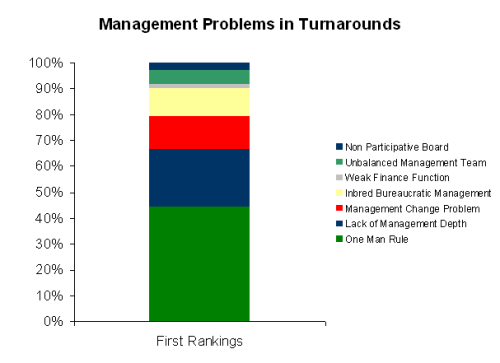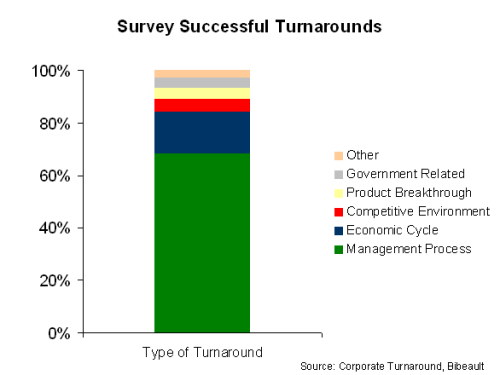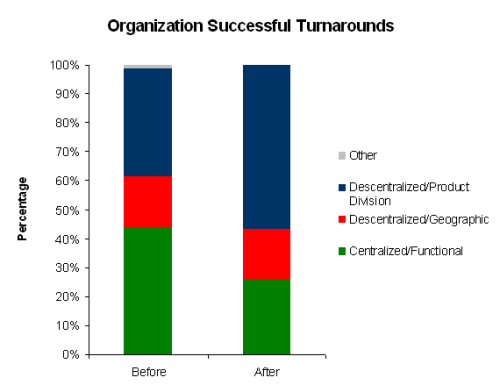Turnaround Cases: Premier Exhibitions Part 3 ($PRXI)
by PlanMaestro
Walshgb, a reader of this blog, was right on the mark when he made this point on management in turnarounds
If you don’t have control, this means you should only focus on turnarounds that already have the right leadership team in place (although, they presumably wouldn’t be in that situation if they were the right team in the first place)?
This Gordian Knot gets cut with the rule number one for successful turnaround investing
RULE #1: FIRST, CHANGE MANAGEMENT
And I am not talking about the hippie projects that IT consultants try to sell nowadays with what used to be just accounting software and now called ERPs. No, it is literally waiting for a change of management before considering investing in a turnaround. And the reason is that most successful turnarounds involve an overhaul of management practices where former leadership is usually the source of the problems.


And that change should specifically include the founder if he is still in place. He already hinted a lack of organizational building skills, or they would not have deep problems in the first place, and will probably be stubborn , a character trait of all successful entrepreneurs. Therefore, any investment margin of safety could be in danger.
There are several types of transition during a corporation life cycle. But my favorite for investing is the transition from creating a business to building an organization. The skills required are so different that VCs usually transition start-up founders and hire professional managers. One particular reason is that entrepreneurs are usually addicted to one-man-rule that can work pretty well in small organizations, but when you get to revenues $50 million plus and growing 20% plus the risks increase. A survey of successful turnarounds gives some evidence that an excessively centralized organization could be at the root of the problems.

And consider that turnaround beginnings usually involve a centralization of power to discipline and focus the organization. However, after the bleeding has been stopped the most appropriate structure for a fast growing company is usually decentralized because it focuses growth where the market signals. This is something that some entrepreneurs do not like or do not get. There are some exceptions though: Bill Gates that was able to grow a great business out of products that were not necessarily the best.
One of the problems of this autocratic structure is that businesses lack processes and financial controls to direct the limited human and financial resources where they are most needed. Entrepreneurs usually do not like processes and controls. Most of them became entrepreneurs in the first place because they did not like processes and controls.
Well there is substantial anecdotal evidence that Premier was internal chaos and a candidate for the fall from grace that we saw in part two. As my wife remarked after reading this post, it seems as an Arrested Development episode
- Disorganized Site Selection: The Bodies explosion to more than 17 exhibits without an organization to manage it was a major disaster. Months of no new exhibits and openings in suburban locations like Branson, Durham, Columbus and Farmingham. The pressures to use the new exhibits lead to some international fiascoes like Russia where new partners did not execute as expected. The bad results compounded by increasing marketing expenditures to turn around these locations. These site selection problems were running the risk of becoming endemic after Arnie Geller fired on his return the sales and marketing department and took personal control of site selection, even though the number of exhibits was much larger than a year ago. As a consequence of Arnie Geller’s unwillingness to delegate, Chris Davino, the new CEO, had to face large programming holes in Q2 and Q3 2009.
- Delays on Permanent Exhibitions: Several delays in getting Bodies Vegas out of the Tropicana and into the Luxor got into everybody’s nerves. The delays were repeated with the Vegas launch of Titanic and Sports Immortals (that was finally canceled). Besides, $12 million in capital expenditures for the exhibition center? That was not pocket change for a small company. The story repeated itself with the permanent exhibition in New York. It took years for the selection of the site in Times Square. However, the Davino’s team has been able to inaugurate it in less than six months.
- Lack of Financial Leadership: There was no real full time CFO in Atlanta until 2008 and earnings surprises were the usual state of affairs. Premier did not even have budgets before the arrival of Bruce Eskowitz. The reason for all this was that Arnie Geller had brought in Stephen Couture in 2006, a young CFO whose only qualification was that his family had inherited a large Premier stake since his father was the former CFO. This resulted in a suspicious incident of a pumped up 68 cents guidance, reiterated in subsequent conference call, that Couture used to sell most of his position. On the next call the guidance was reduced by over 50%.
- Excessively Promotional: Timothy Sykes was right on this point, management was overly promotional. For example, Arnie Geller commented in a conference call that the share price would be $30 in a couple of years and, adding to the guidance incident, he was in several publications sharing overly optimistic revenue projections that were more that twice peak levels. His phrase “Should have looked right and left” has become part of the company folklore.
- Secondary Accounting Firm: The use for several years of Kempisty and Co., a little known accounting firm, while resisting the pressure to change it was at least highly suspect. Premier finally engaged Cherry, Bekaert & Holland, L.L.P, a large regional firm, as a result of Marc Sellers’ activist pressure. Why Kempitsky in the first place? We will probably never know.
- Second Class Event Marketing: several exhibits were promoted only a couple of weeks in advance. The excuse was that their competitor could jump in if they promote it too soon. Given the related evidence, it seems that the real reason was last minute decisions on site selection. The consequence was under promotion of exhibits and the lack of access to some museums that needed advanced scheduling. Also merchandising and sponsorship revenue was almost negligible and Premier’s internet site was a laughing stock. They did not remove closed exhibits and did not add exhibits close to openings.
- Nepotism: Judy Geller, the wife of Arnie Geller, was a consultant to Premier and received payments of approximately $100K during 2007. In addition, she also received royalty payments on the sale of the exhibition catalogs of approximately $197K. How can someone justify this? One of the directors was also Arnie Geller’s nephew while he received many times the normal director compensation while failing to disclose he was a relative. If these incidents were not enough, Arnie Geller was still getting paid a$675K CEO and President salary after Bruce Erkowitz was hired adding to the SG&A expense issues. And the clique was back when Arnie came back, hiring several family members.
- Geller’s Inability to Delegate: Bruce Erkowitz was fired but most senior management decided to leave promptly after Geller’s comeback. CFO Bud Ingalls even made the unusual step of saying publicly that Arnie Geller was the reason for his resignation. The CFO, VP exhibits, VP Sales/Marketing, VP Strategy, VP Sponsorships were all gone by late 2008. That had also an impact in running costs; the company had to pay some of them for another year after their decision.
- Titanic Trial the long time to reach a conclusion was endangered with a company statement on ownership of the Titanic property when they only had rights to salvour-in-possession. Why risk a district court response when you are still negotiating the covenants and conditions for a sale?
- Botched Dialog in the Dark launch: Premier did virtually nothing to promote it and the selection of Kansas City for a liberal exhibit certainly was head scratching. Reviews have been very good and the creator was even invited to TED. However, word of mouth most certainly takes time and Premier’s divided attention did not help.
And this is just a summary of the problems of the lack of control and procedures in this autocratic organization. Is Arnie Geller incompetent? No need to make judgment. As investors -not as judges, lawmakers or journalists- the important thing is that there is a pattern, the one man rule story, that has provided and will provide opportunities. So it does not matter if the reason is incompetence, bad luck, entrepreneurial psychology, or an organizational cycle. One big advantage of turnaround investing, for example compared with growth investing, is that we do not have the difficult task of picking ex ante the next Bill Gates. We can instead wait for the fall and the following arrival of professional management. Also, if a company had good years with such a chaotic organization imagine what it can do with a well functioning one. So it is time to hear Premier’s new management turnaround plan.
Long PRXI
[…] This little experiment burned $20 million in cash and left Premier at the brink of collapse. You need the discipline to shut down your best ideas, Arnie Geller and Bruce Eskowitz were not capable of doing that. Premier looks too much like the pattern of a one-man rule. Confirmatory evidence would be a disorganized culture and organization. That is what we are going to review next. […]
Great due diligence maestro.
Thoroughly enjoyed reading this and your take on PRXI.
It is not so difficult to know the dirt when there is a proxy fight. Another plus for turnaround investing, you get to know the dirt.
[…] 15, 2009 by PlanMaestro So now we know we now how Premier got in trouble, no it is time to evaluate the new management plan to turn the company around. And, as we learned […]
[…] take it private. Having failed, he stepped down as chief executive in May 2008. Those of you that have followed the Premier Exhibitions posts know how I consider waiting for change of management a critical first […]
Premier is still out there with their questionable body exhibits. How long can they keep this up with Republicans and Democrats sounding the alarm in Missouri and Arizona?
Historically the controversy has been good marketing. It has been investigated but nothing found.
Hey PlanMaestro,
I was just wondering what your recent thoughts are on PRXI following 1Q earnings and the announcement that Sellers will be selling his stake. Just curious to hear what your current views are on the situation.
It was always known that Sellers was winding down his fund, and his announcement that he would be selling in a year year and half clarifies issues. I only hope that this announcement does not stop him or the company from buying shares.
A little more worrying is the revenues pressure. I like that the company has achieved cash flow break-even despite this and is starting to invest in new businesses. But I would classify it as an average turnaround so I reduced my position to an average position.
[…] the effort to rescue the artifacts given the costs and risks of the expeditions. In passing, Arnie Geller gets his a ear twisted for his efforts to blindside the court, but that is old […]
my name is STEPHEN COUTURE my dad’s name was GERALD COUTURE ? is when are you people going to realize you will be held accountable for your actions. The fraud within your manipulative planning will be exposed. Sincerely Yours Stephen Couture President CEO TEL# 1-508-746-8176
Nice to meet you Mr Couture. Is there anything in this post that you consider factually incorrect?